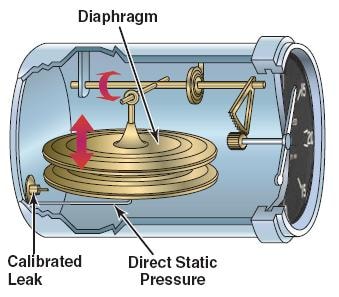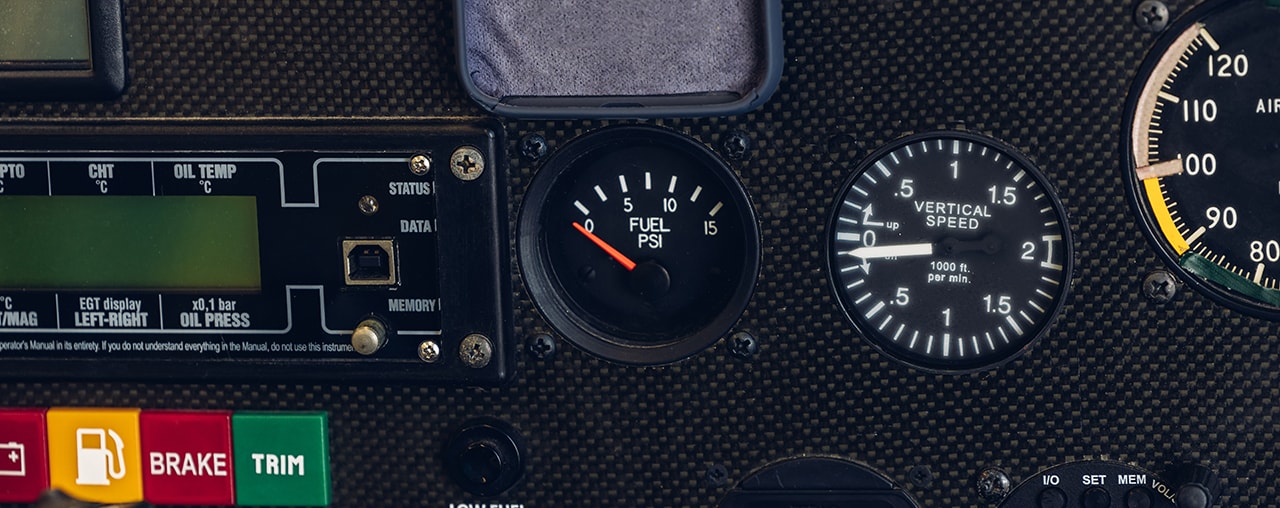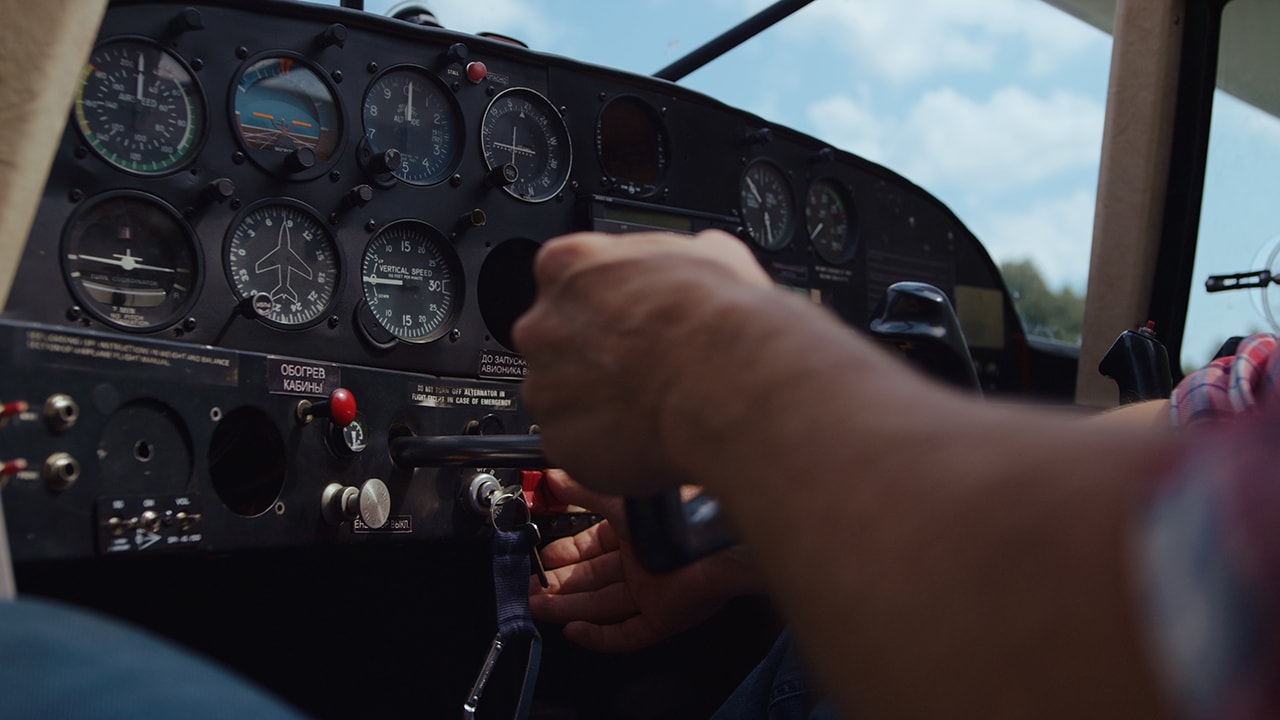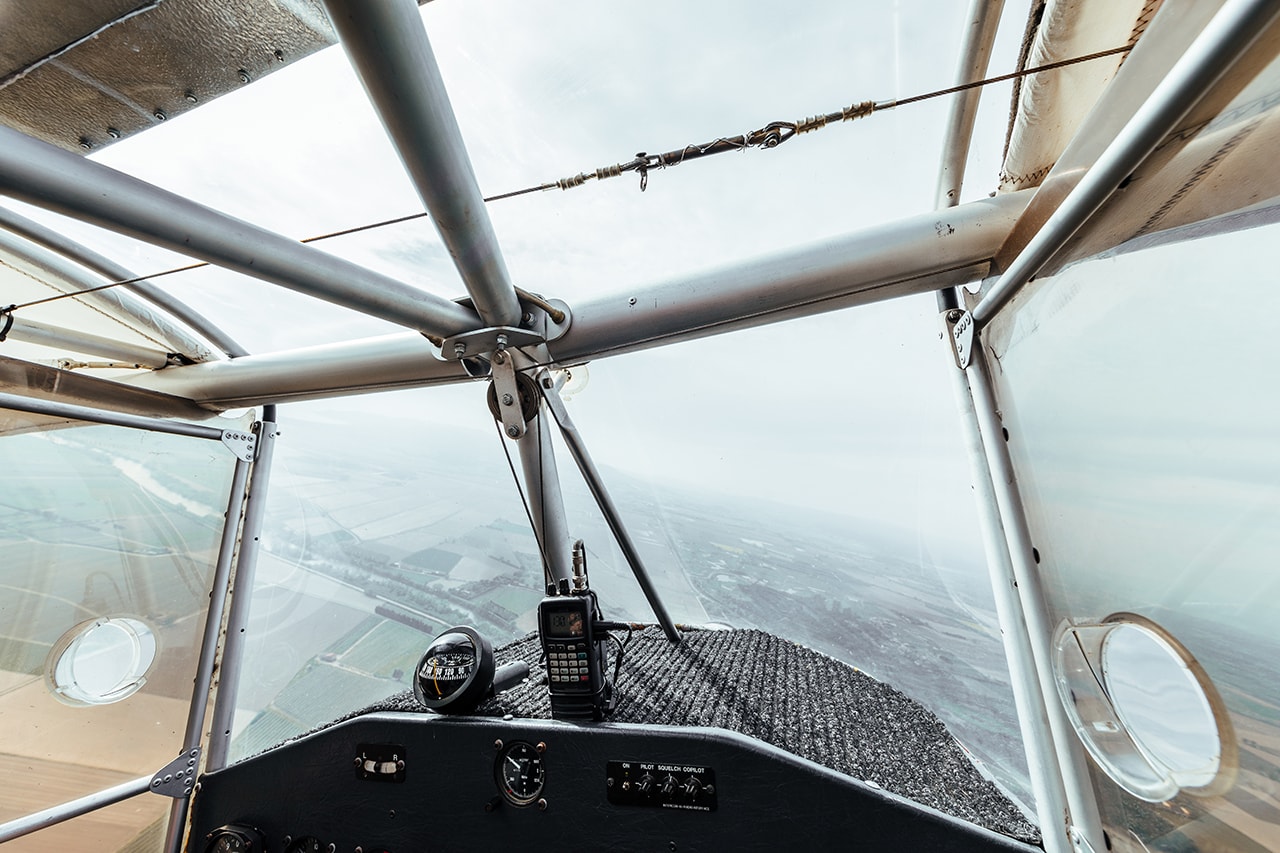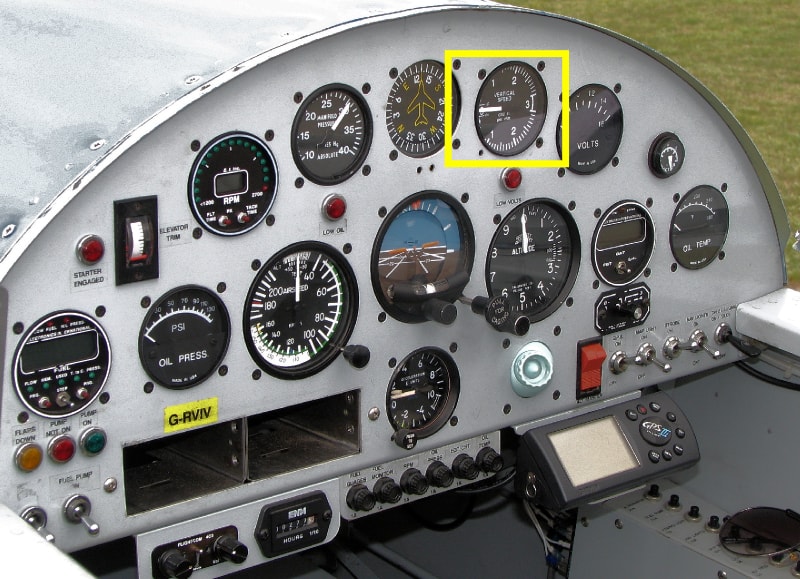How Does a Vertical Speed Indicator Work? Easy Guide
Oct 08, 2024
What is a Vertical Speed Indicator?
In a nutshell the Vertical Speed Indicator (VSI) gives you the rate at which the aircraft is climbing or descending. Flying through clouds and want to know you’re on a safe flight path? The VSI gives you instant feedback.
This instrument shows you the rate of climb or descent in feet per minute, so you can make decisions in a hurry during takeoff and landing or when flying through turbulence.
The vertical speed indicator shows real-time data, helping pilots maintain control during critical phases of flight. The airspeed indicator measures crucial data that, combined with the VSI readings, helps ensure a safe flight experience.
The VSI works on the principle of measuring changes in air pressure. It uses a diaphragm and a calibrated leak which measures the pressure changes as the aircraft moves vertically.
This is then translated into the needle movement so you can see the aircraft’s vertical speed.
By understanding how this works you can gain confidence in your instruments and improve flight safety and performance. In aviation the VSI is also known as the rate of climb indicator, vertical velocity indicator, or variometer.
Each name describes its function – tracking the rate of ascent or descent. Whatever the name the purpose remains the same – to give you feedback on altitude changes.
This flexibility in terminology shows its importance across different types of aircraft and flying conditions.
Being part of the “six pack” of instruments shows its importance. The six pack are the foundation of a pilot’s toolbox and give you all the data you need for airspeed, altitude, attitude, heading and turning coordination.
In this set the VSI stands out for its vertical focus. Together these instruments give you situational awareness which is essential for safe and successful flight and makes flying not a daunting task but an achievable and enjoyable one.
Main Components and Working Principle
To understand how a Vertical Speed Indicator (VSI) works you need to understand the main parts.
The diaphragm is the heart of the system. It’s a flexible metal container that expands and contracts with air pressure.
Connected to the static air source of the aircraft the diaphragm reacts to pressure changes which are directly related to the aircraft’s vertical movement. This sensitive reaction gives pilots real time feedback on altitude changes.
Just as important is the calibrated leak often overlooked because of its small size but big function.
It restricts the airflow from the VSI casing to the static source, creating a pressure differential that is crucial for the functioning of the VSI. This restriction is critical because it creates a pressure difference across the diaphragm.
The pressure inside the instrument case is higher because of a calibrated leak that’s designed to delay the pressure equalization by a little bit.
This higher pressure ensures the needle on the VSI moves smoothly and gives pilots an accurate indication of rate of climb or descent. This steady feedback loop helps pilots stay on vertical center throughout their flight.
Then there’s the needle - the visual communicator to the pilots. This part of the VSI is sensitive enough to show even the smallest of changes and moves up and down the scale quickly to indicate rate of climb or descent.
While it’s one of the simplest parts in terms of structure it’s a critical role. It converts the mechanical movements within the instrument into visual cues so pilots can make informed decisions and adjust with confidence.
Together they work in harmony, the perfect balance of mechanical and visual. By using the static air source within the aircraft, the VSI converts complex environmental data into simple and actionable information.
This gives pilots the strategic edge, safety and the overall flying experience, makes aviation accessible to all.
How a Vertical Speed Indicator Works
A Vertical Speed Indicator (VSI) is a vital instrument for pilots that tells you how fast you’re climbing or descending. It works on changes in air pressure, looking at the static pressure as you climb or descend, which reflects altitude changes.
Understanding What does the Vertical Speed Indicator do is essential for pilots to maintain optimal flight performance.
Barometric pressure plays a critical role in the functioning of the VSI, as it affects the pressure differentials within the pitot-static system.
As the aircraft climbs, the static pressure decreases around the VSI. The diaphragm inside the VSI expands. The pressure inside the instrument case is higher because of a calibrated leak that’s designed to delay the pressure equalization by a little bit.
This difference in pressure between the diaphragm and the case moves the diaphragm in. Connected to this diaphragm are gears that translate its movement into a motion of the VSI needle, showing the rate of climb on the dial.
The greater the pressure difference the more the diaphragm moves, and the needle responds. This gives the pilot clear visual information on how fast the aircraft is climbing or descending.
The calibrated leak in the VSI delays the instrument for a few seconds. This gives the pilot trend information so they can anticipate changes in the climb or descent rate and make smoother and safer adjustments.
Understanding Vertical Airspeed
Vertical speed is key to understanding because it tells you how your aircraft is performing in 3D space. Ground speed tells you how fast you’re moving over the earth's surface. Vertical speed tells you how fast you’re moving up or down.
During level flight, the Vertical Speed Indicator (VSI) helps pilots monitor their aircraft's altitude changes, indicating when the aircraft is neither climbing nor descending, which is crucial for maintaining precise control in aviation.
This is critical for safe flight, especially during climb or descent. By monitoring vertical speed, you can manage your climb angles and descent rates and stay within safe limits.
When talking about rate of climb you need to consider it’s related to two airspeeds: Vx and Vy. Vx is the airspeed at which the aircraft will climb at its best angle. It's for getting up high in the shortest distance possible. This is important when clearing obstacles during takeoff.
Vy is the airspeed for maximum rate of climb. This is for getting up high in the shortest time possible. Understanding and using Vx and Vy in practice is key to minimizing fuel and safety margins during climb.
And rate of descent (sink rate) is critical information during landing and approach.
By watching the vertical speed indicator, you can see what adjustments need to be made to get a smooth descent. This allows you to make decisions like when to deploy flaps or throttle which will get you a safe and efficient landing.
By keeping an eye on these things, the aircraft will behave, and everyone will have a good time.
Types of Vertical Speed Indicators
Vertical Speed Indicators (VSIs) are key in aviation, they help pilots monitor the aircraft’s vertical motion. They show how fast the aircraft is climbing or descending, which helps provide a safer and more efficient flight.
-
Standard VSIs use the pitot-static system to get the data. The static pressure port in this system measures atmospheric pressure, which is crucial for accurately calculating vertical speed and ensuring flight safety, while the pitot tube measures dynamic pressure for airspeed calculation.
-
Instantaneous Vertical Speed Indicators (IVSIs) have a quicker response time. Unlike standard VSIs, they use accelerator-actuated air pumps to show the changes in vertical speed immediately.
IVSIs have accelerometers along the vertical axis. This allows IVSIs to detect changes in ascent or descent faster, gives pilots a more immediate readout of vertical speed changes.
The fast-acting nature of IVSIs gives pilots real time data. This is especially useful during rapid altitude changes, makes flight safer and more controllable.
In general, both types of VSIs are important in aircraft operations. Whether through the traditional pitot-static method or the advanced accelerometer-aided method, VSIs are essential in altitude control.
Calibration and Accuracy
Calibration and accuracy are key to a vertical speed indicator (VSI) working for pilots. During manufacturing the VSI goes through a very thorough calibration process to ensure the internal mechanisms match the aircraft’s vertical speed.
This involves tweaking the instrument to respond to static pressure changes.
A VSI’s accuracy can be influenced by the instrument itself, the installation and the aircraft’s pitot-static system maintenance.
A well calibrated VSI will give you readings within ±10% of the actual vertical speed which is important for decision making during flight.
To achieve this level of accuracy pilots should check the VSI’s calibration regularly and make any necessary adjustments. This involves comparing the VSI readings to known reference points and making corrections as required.
And following the manufacturer’s maintenance schedule is important to prevent errors or failures. Regular inspections and maintenance of the pitot-static system which includes the static port and other components will keep the VSI working.
Calibration and accuracy (including altitude) means you can trust your VSI.
Integration with Other Avionics Systems
A vertical speed indicator (VSI) is often combined with other avionics to give the pilot a full picture of the aircraft’s performance. This combination makes the VSI more useful and safer to fly.
One of the combinations is with the autopilot. When connected the VSI tells the autopilot to adjust the pitch and yaw to maintain a steady vertical speed. This automatic adjustment gives smoother climbs and descents, reduces pilot workload and stability.
The VSI can also be combined with the flight management system (FMS). FMS uses the VSI data to calculate the climb or descent rate and adjust the flight plan.
This shows the flight path and performance of the aircraft, making it easier to manage vertical speed in all phases of flight.
Also, the VSI can be connected to the electronic flight instrument system (EFIS). The EFIS shows the flight instruments of the aircraft, including the VSI.
This graphical view of the VSI makes it easy to see the vertical speed, situational awareness.
In general, the integration of VSI with other avionics makes flight operations safer and more efficient.
By providing accurate and timely information about the aircraft’s performance, these integrated systems help pilots make informed decisions and maintain optimal flight conditions.
Practical Applications and Safety Considerations
Vertical Speed Indicators (VSIs) are safety critical, giving you real time rate of climb or descent. The vertical speed indicator shows the rate of climb or descent in feet per minute, providing real-time data for pilots.
By telling you of any change in vertical speed these instruments allow you to make precise adjustments to keep the flight path stable. This instant feedback is critical during rapid altitude changes, safety and control.
From a practical standpoint pilots benefit greatly by understanding the lag between the trend and the actual rate on traditional VSIs.
An Instantaneous Vertical Speed Indicator (IVSI) reduces this lag and prevents over correcting the aircraft. You can manage altitude transitions with confidence and have a smoother more controlled flight.
Understanding Trends
Pilots need to be able to tell the difference between trend and rate when looking at VSI. Trends give you an initial indication of a change in vertical speed, but there’s always a short delay before the actual rate of climb or descent is displayed due to the pressure differential.
Variations in static pressure, created by climbing or descending, result in a pressure differential that influences the movement of the VSI needle, causing this delay. This delay can be critical in certain situations.
By being aware of this delay, you can avoid overreacting to the initial reading and make smoother altitude changes. Knowing the difference between trend and rate gives you situational awareness and a more stable flight.
Traditional VSI Limitations
Traditional Vertical Speed Indicators (VSIs) have some limitations pilots need to be aware of, particularly how static pressure decreases as one climbs in altitude.
This reduction in static pressure leads to a pressure differential, which can affect the movement of the instrument's needle, causing it to show slow and small changes in vertical speed more quickly, which can be misleading.
This requires pilots to be proactive and anticipate changes in their flight path to make smooth and controlled movements.
With an understanding of these limitations, pilots can prepare themselves better during flight.
By adding foresight to their decision making, they can manage vertical transitions better. This makes for a safer flight and a more enjoyable flight for everyone on board.

IVSI Advantages
Instant Vertical Speed Indicators (IVSIs) give you a safety advantage by showing vertical speed changes instantly. During aircraft climbs, IVSIs quickly respond to the decrease in static pressure, providing immediate feedback on the rate of climb.
This reduces the delay you get with traditional VSIs so you can make quicker, more precise corrections. By reducing reaction time IVSIs help you stay in control without over correcting.
For you that means a smoother, more confident flying. IVSIs prevent errors caused by delayed readings so overall safety and comfort of flight.
In short IVSIs let pilots navigate vertical transitions with more confidence and accuracy for themselves and their passengers.
Maintaining Stability
Stability during flight is key to safety and passenger comfort. Level flight is crucial for maintaining stability, as it ensures the aircraft is neither climbing nor descending. Instant Vertical Speed Indicators (IVSIs) help by giving real time feedback on vertical speed changes so pilots can adjust without second guessing.
This reduces the chance of over correction and lets them stay on course with minimal disturbance.
In the end IVSIs mean more stable flight. By reducing the wobbles and the transitions these indicators give a sense of security for everyone on board. Pilots feel more in control and passengers have a better journey, that’s the benefit of modern aviation.
Conclusion
In aviation both VSIs and IVSIs are important instruments. Barometric pressure plays a critical role in the functioning of these instruments, as it affects the vertical speed indicator by providing essential information about the aircraft's rate of climb or descent through pressure differentials within the pitot-static system.
Each type of instrument has its use, for safety and efficiency of flight. VSIs are tried and true instruments that have been around for years, giving pilots the data they need for rate of climb or descent.
IVSIs have taken it a step further and give real time feedback which is key in today’s fast-paced aviation.
They allow pilots to react to any vertical speed changes instantly and reduce over correction and smooth the flight for both crew and passengers.
This is another step in the evolution of aviation safety. Knowing how and when to use both will help you stay stable in flight.
Each has its limitations and knowing those will help you make informed decisions and get the best out of the aircraft. VSI or IVSI knowledge is the foundation for pilots who want to deliver a 5-star flying experience.
In the end it’s more than just safety, it’s about the overall flying experience. Pilots with this knowledge will be confident in their navigation and every flight will be safe and comfortable for all passengers.
That’s the inclusive benefit of technology in aviation.
